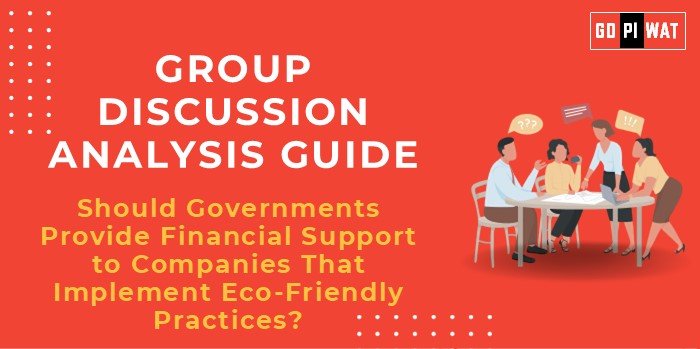📋 Group Discussion Analysis Guide: Should Governments Provide Financial Support to Companies That Implement Eco-Friendly Practices?
🌐 Introduction to the Topic
Opening Context: As climate change escalates globally, governments face a crucial question: should they incentivize eco-friendly practices to promote sustainability while balancing economic development?
Topic Background: Financial incentives for eco-friendly practices are not new. Programs like tax breaks and subsidies have been implemented globally, but their efficacy in achieving long-term sustainability remains debated.
📊 Quick Facts and Key Statistics
- 💰 Global Green Subsidies: $1 trillion allocated globally to renewable energy in 2023, showing increasing government commitment.
- 🌍 Carbon Pricing Programs: 68 countries implement carbon pricing to penalize non-sustainable practices (World Bank, 2023).
- 🏢 Corporate Participation: Over 2,000 companies commit to net-zero goals, spurred partly by government incentives (UNFCCC, 2023).
- 🇮🇳 India’s Green Initiatives: ₹19,500 crore allocated for solar manufacturing under the Production Linked Incentive (PLI) scheme in FY 2023-24.
🧑🤝🧑 Stakeholders and Their Roles
- 🏛️ Governments: Formulate and implement policies; provide funding and tax incentives.
- 🏢 Private Companies: Adopt eco-friendly technologies and practices.
- 🌱 Environmental Groups: Advocate for sustainable policies and monitor outcomes.
- 👥 Consumers: Drive demand for eco-friendly products, influencing corporate strategies.
🏆 Achievements and Challenges
🎯 Achievements:
- Economic Growth: Green energy investments contribute to GDP growth (e.g., India’s renewable energy sector grew by 10% in 2023).
- Job Creation: Renewable energy sectors employ 12.7 million people globally (IRENA, 2023).
- Carbon Reduction: Countries like Denmark report a 70% reduction in emissions due to green policies.
⚠️ Challenges:
- Cost Burden: High initial investment for companies, particularly SMEs.
- Greenwashing: Firms may misrepresent eco-claims to qualify for subsidies.
- Policy Gaps: Inconsistent or poorly monitored policies reduce impact.
Global Comparisons:
• Success: Germany’s Energiewende policy highlights robust green industry growth.
• Challenges: The U.S. Inflation Reduction Act faces scrutiny over trade disputes.
📋 Structured Arguments for Discussion
- Supporting Stance: “Subsidies encourage innovation and adoption of green technologies, essential for combating climate change.”
- Opposing Stance: “Government funds could be better allocated to systemic solutions like public transport rather than subsidizing private firms.”
- Balanced Perspective: “While eco-friendly subsidies have clear benefits, stricter monitoring is required to prevent misuse.”
💬 Effective Discussion Approaches
- 💡 Opening Approaches:
- “With $1 trillion spent globally on green subsidies, evaluating their effectiveness is imperative.”
- “Are subsidies the most effective tool for encouraging corporate sustainability?”
- 💡 Counter-Argument Handling:
- Present data (e.g., greenwashing cases) to challenge subsidy misuse claims and propose solutions like audits.
📈 Strategic Analysis of Strengths and Weaknesses
Strengths:
- Encourages innovation.
- Enhances global competitiveness in green tech.
Weaknesses:
- Risk of greenwashing.
- Dependency on subsidies.
Opportunities:
- New markets for sustainable goods.
- Partnerships between public and private sectors.
Threats:
- Policy instability.
- Economic downturns impacting funding.
📚 Connecting with B-School Applications
- Real-World Applications: Eco-friendly subsidies link to project themes in sustainable finance and operations management.
- Sample Questions:
- 🧐 “How do eco-subsidies contribute to sustainable economic growth?”
- 📘 “What measures can prevent greenwashing in corporate subsidy claims?”
- Insights for Students: Opportunities in sustainability-focused roles like ESG consulting and green project management.


